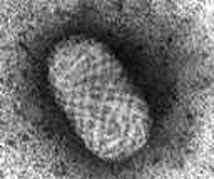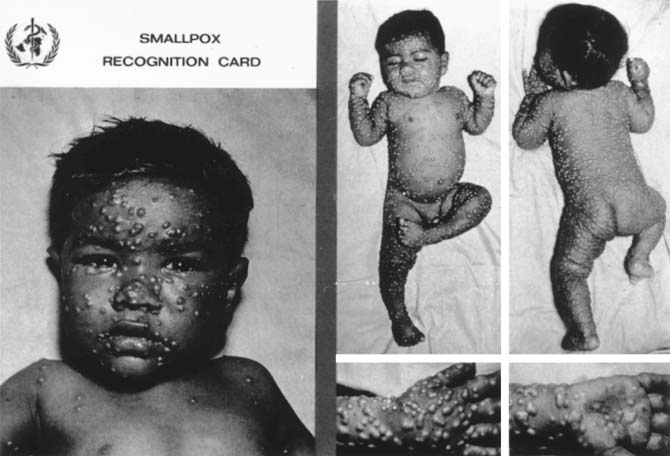
Introduction
Classification: Poxviridae is named so due to the pustules (pox) that it causes on its host. The Poxviridae family is split into two subfamilies, Chordopoxvirinae and Entomopoxvirinae. There are eight genera in Chordopoxvirinae: Orthopoxvirus, Parapoxvirus, Avipoxvirus, Capripoxvirus, Leporipoxvirus, Suipoxvirus, Molluscipoxvirus, and Yatapoxvirus. The viruses in this subfamily can infect various mammals and birds. The orthopoxviruses have been the most studied viruses. In the Entomopoxvirinae subfamily, there are three genera: Entomopoxvirus A, B, and C. Viruses in this subfamily only infect insects. Viruses of the same genus show antigenic, morphologic, and host range similarity.
Virion: The virion is about 200-350 nm by 115-260 nm, thus it is considered to be a very large virus and can be seen under a light microscope. In addition, the capsid morphology is neither icosahedral nor helical. In fact, the morphology is complex with either an ovoid or brick-shaped nucleocapsid containing a biconcave core and two lateral bodies. The capsid can be surrounded by an envelope such as in orthopoxvirus, or can be nonenveloped such as in parapoxvirus.
Genome: Poxviridae contains linear, double-stranded DNA that can range from 130 kbp to 230 kbp. The nonsegmented and noninfectious genome encodes for more than 100 genes. In addition, the genome contains inverted terminal repetitions (ITRs), which include a hairpin loop that connects the two strands of DNA.
Transcription: The poxviruses are the only DNA animal virus to be able to replicate in the cytoplasm of host cells. The virus uses virally encoded enzymes, such as RNA polymerase, mRNA capping enzymes, and polyA synthetase, to produce capped and polyadenylated mRNA. Transcription of the genome can be split into early, intermediate, and late genes.
General info on smallpox vaccination: Immunizations began with the smallpox (variola) virus. It was observed that exposure to dried smallpox lesions induced milder infections and lifelong immunity.  However, many times this also caused inoculated individuals to develop severe smallpox resulting in death. Then Edward Jenner, in the 19 th century, noticed that milkmaids exposed to cowpox would develop immunity for smallpox. Jenner, ended up isolating the vaccinia virus in the process of obtaining the cowpox virus for use in vaccinations. The vaccinia virus is of an unknown origin and is different from both variola and cowpox. However, as it is able to induce immunity to smallpox, vaccination programs have used the vaccinia virus. The World Health Organization, in 1967, proclaimed that smallpox must be eradicated from the world by the end of the 20 th century, and thus they launched a massive immunization campaign. The last outbreak occurred in Somalia in 1977, and smallpox was officially declared eradicated in 1980. Although, there are still two known stockpiles of smallpox virus; one in the CDC and one in the former USSR.
However, many times this also caused inoculated individuals to develop severe smallpox resulting in death. Then Edward Jenner, in the 19 th century, noticed that milkmaids exposed to cowpox would develop immunity for smallpox. Jenner, ended up isolating the vaccinia virus in the process of obtaining the cowpox virus for use in vaccinations. The vaccinia virus is of an unknown origin and is different from both variola and cowpox. However, as it is able to induce immunity to smallpox, vaccination programs have used the vaccinia virus. The World Health Organization, in 1967, proclaimed that smallpox must be eradicated from the world by the end of the 20 th century, and thus they launched a massive immunization campaign. The last outbreak occurred in Somalia in 1977, and smallpox was officially declared eradicated in 1980. Although, there are still two known stockpiles of smallpox virus; one in the CDC and one in the former USSR.
Now that you’ve learned a little more about the Poxviridae family, be sure to look around and enjoy the various pages that I’ve made for your viewing pleasure. YOUR satisfaction is MY pleasure.
This site was created by Nate Hsu in Nov. 2005 for HumBio 115A (Humans and Viruses) taught by long time Stanford University Professor Robert Seigel.